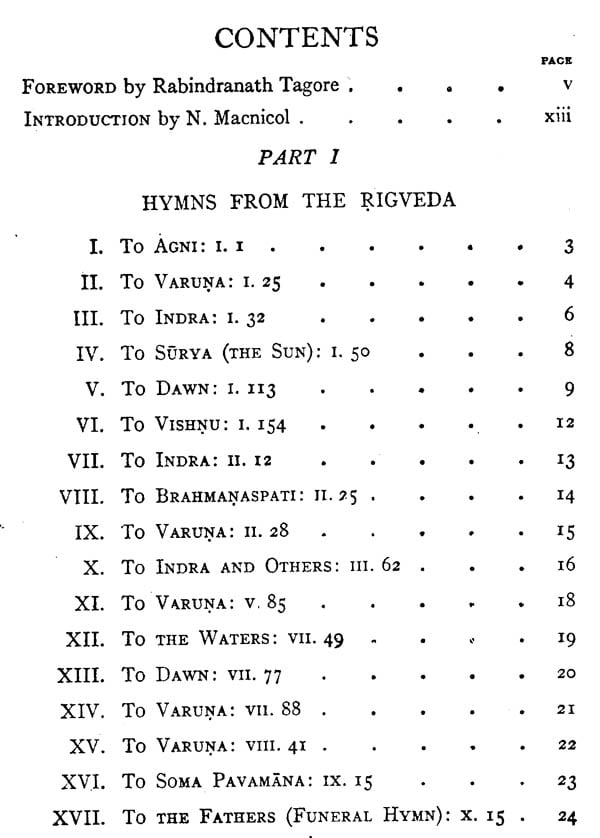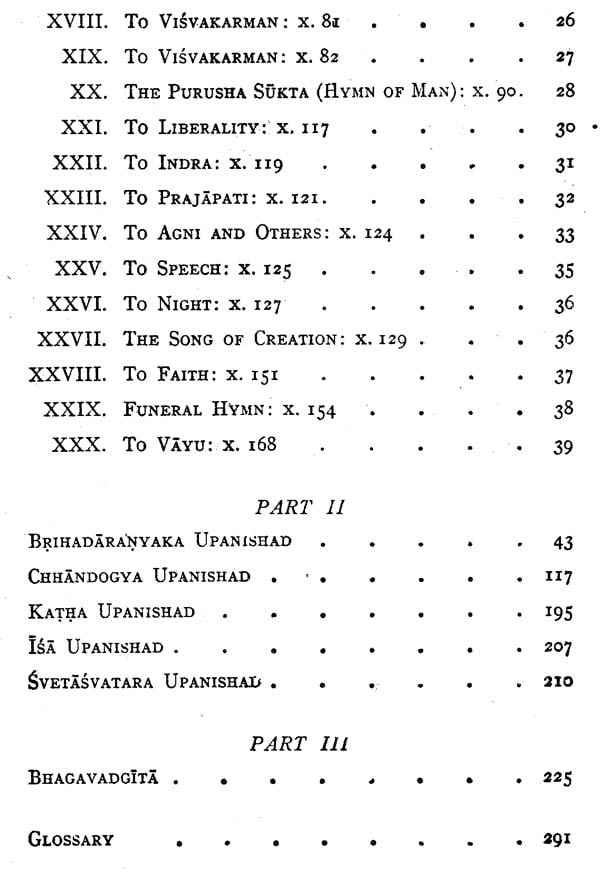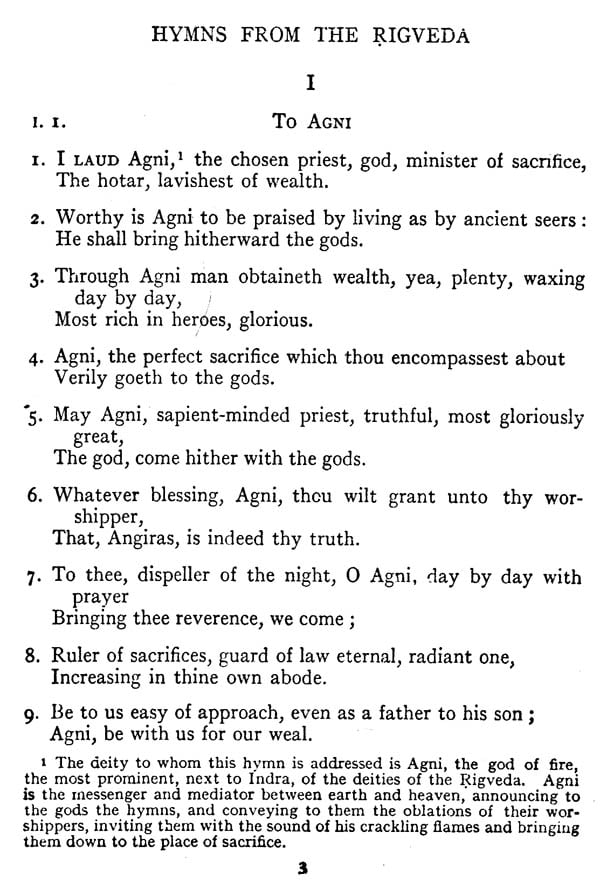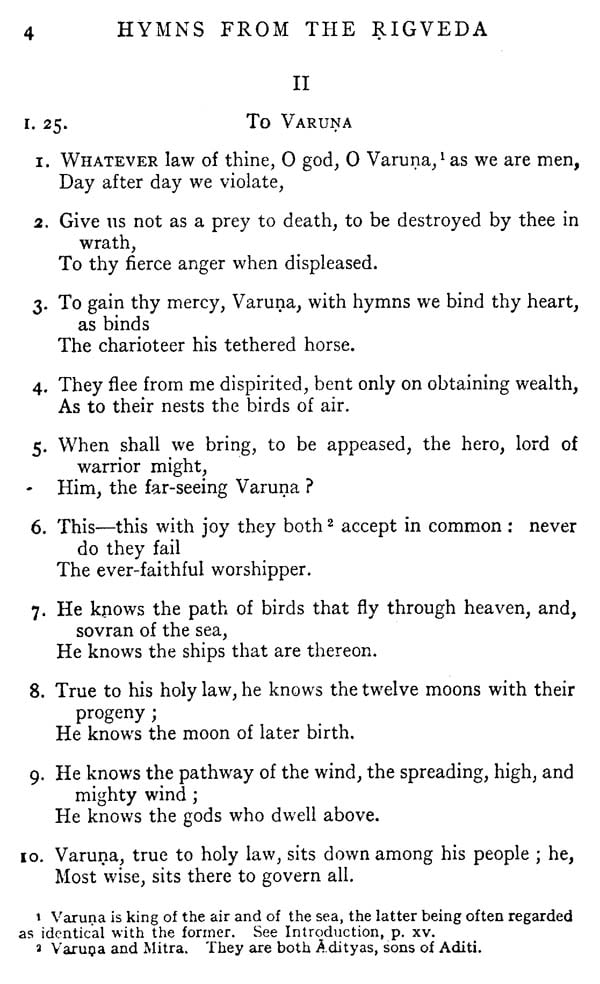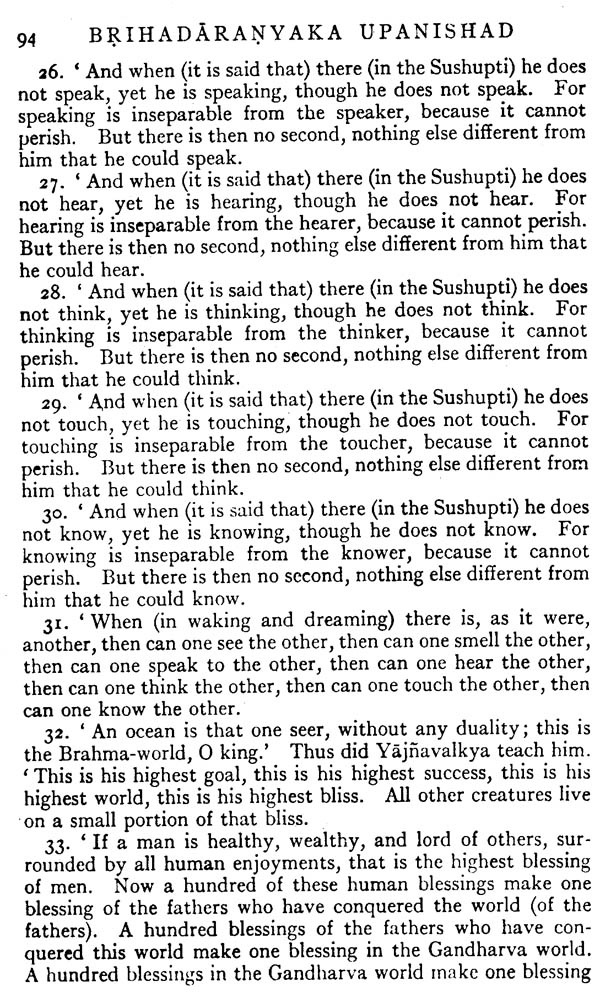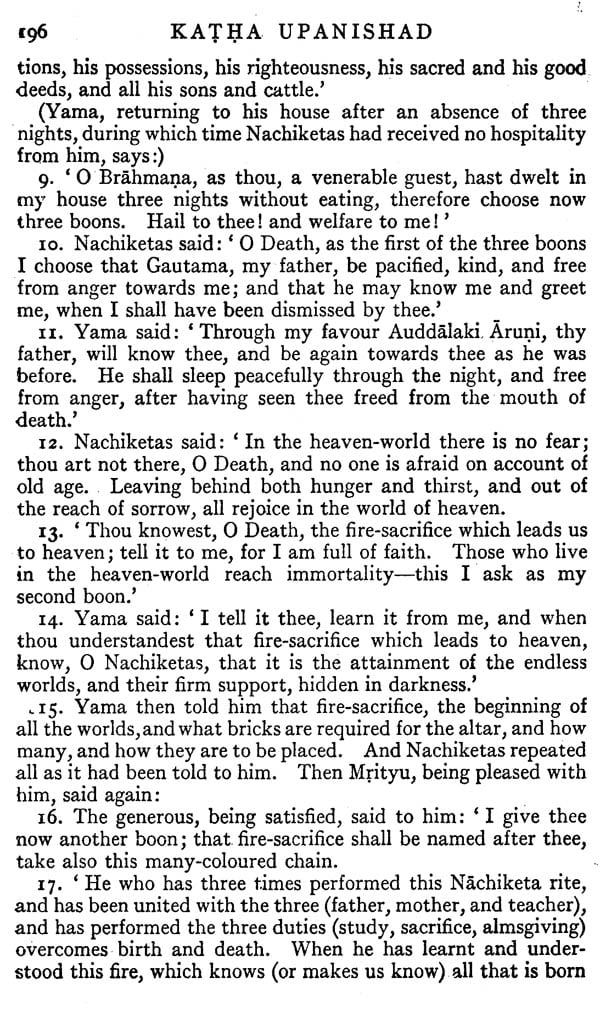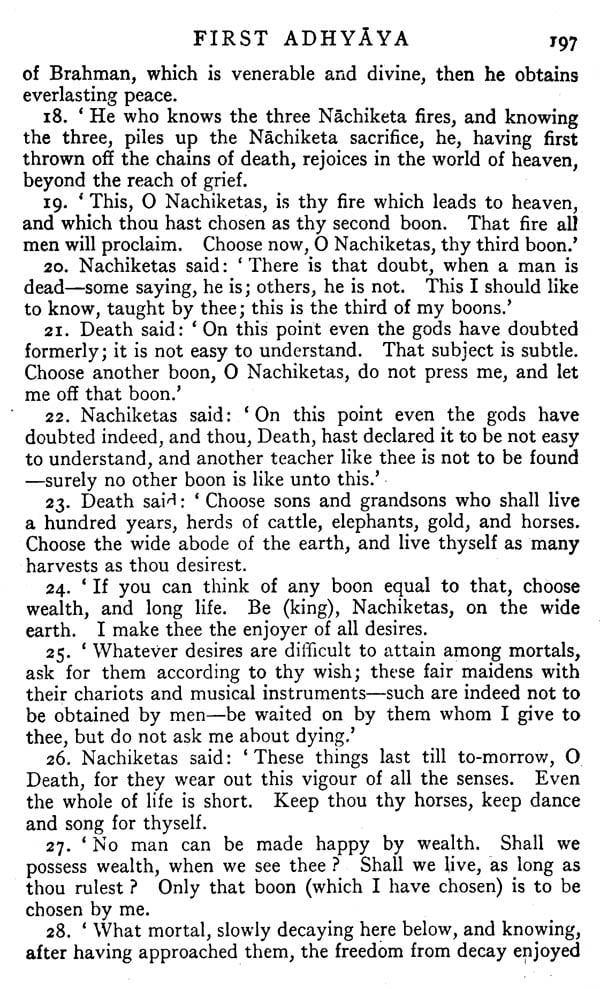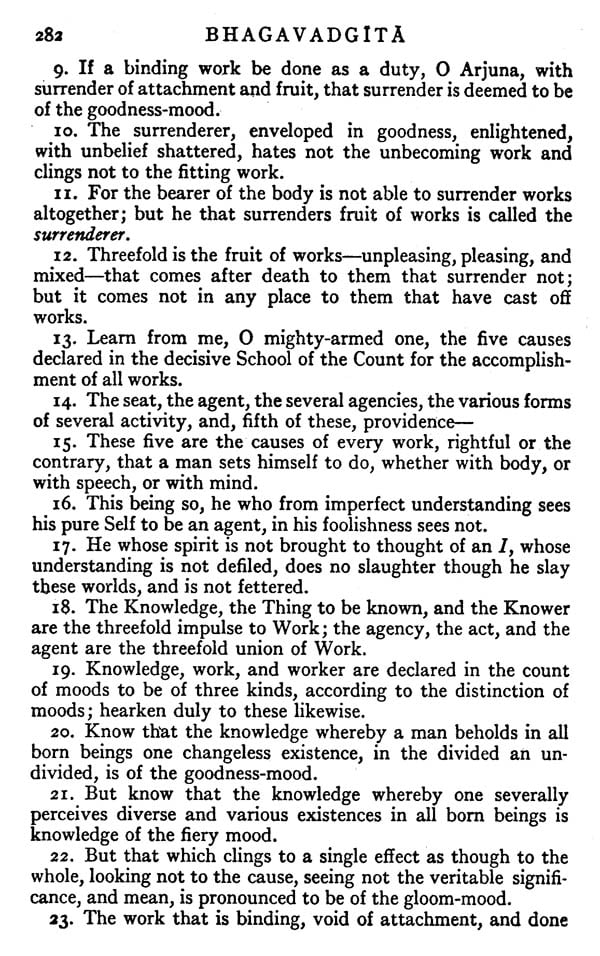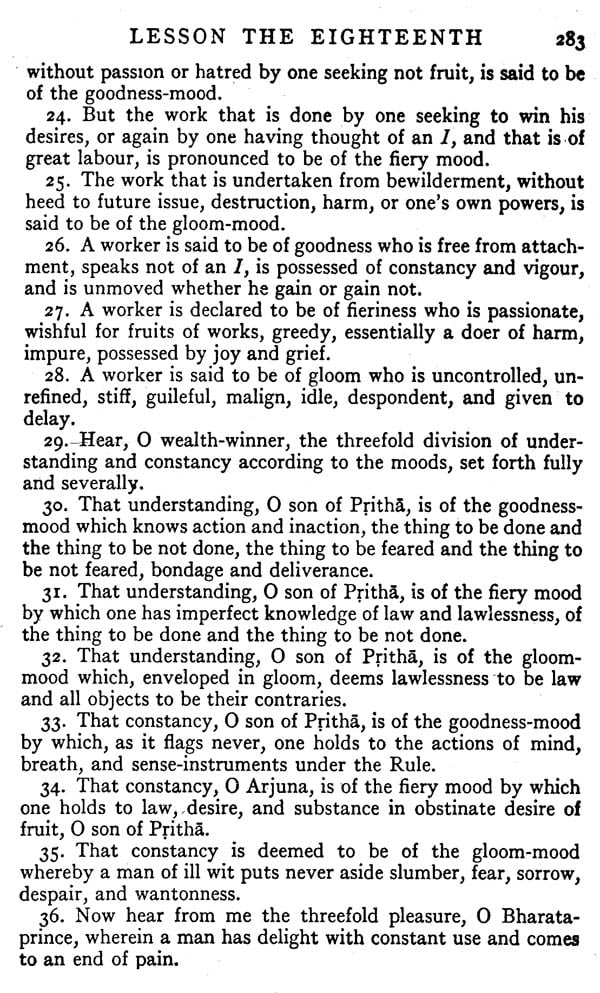
Hindu Scriptures (Hymns from the Rigveda, Five Upanishads and The Bhagavadgita)
Book Specification
| Item Code: | NAV338 |
| Author: | Nicol Macnicol and Rabindranath Tagore |
| Publisher: | Cosmo Publications, New Delhi |
| Language: | English |
| Edition: | 2003 |
| ISBN: | 9788129200532 |
| Pages: | 296 |
| Cover: | PAPERBACK |
| Other Details | 7.00 X 5.00 inch |
| Weight | 270 gm |
Book Description
HINDU SCRIPTURES provides an insight into the inspiration and development of one of the oldest of the living religions. The scriptures chosen to represent the spiritual and philosophical heritage of the Indians are a testament to a people's collective reaction to the wonder and awe of existence.
It was a simple faith of the ancient Indians that attributed divinity to every element and force of nature, but it was a brave and joyous one, in which fear of the Gods was balanced by trust in them, in which the sense of mystery only gave enchantment to life, without weighing it down with bafflement.
The book is a wonderful journey starting from the Vedic simplicity illumined by intuitive experience ['Truth is one: (though) the wise call it by various names' (Rigveda | 164. -46)] to the deepened and widened meditations of the Upanishads shifting the keener spiritual longing to the ‘Self from the outside world: finally to the expounding of the harmony between diverse approaches to the Reality through the paths of knowledge, love, righteousness and detached living of the Bhagavadgita.
This book as a representative of the entire range of Indian spiritual and philosophical speculation and practices Introduced by no less a person then the Noble Laureate Rabindranath Tagore.
That Religion, though not infrequently administered as opiate to the people, did not always originate as such, is often ignored by thinkers whose intellectual bias inclines them to purely economic interpretations of social phenomena. A publication therefore which is likely to provide an insight into the inspiration and development of one of the oldest of the living religions, should be welcomed by all intelligent and impartial readers.
Perhaps the most significant thing that strikes the reader as he goes through some of the Vedic Hymns collected here is that they read, not like so many commandments, enjoined by priests or prophets, which in the European mind are identified with Oriental religions, including Christianity, but as a poetic testament of a people’s collective reaction to the wonder and awe of existence. A people of vigorous and unsophisticated imagination awakened at the very dawn of civilization to a sense of the inexhaustible mystery that is implicit in Life. It was a simple faith of theirs that attributed divinity to every element and force of Nature, but it was a brave and joyous one, in which fear of the gods was balanced by trust in them, in which the sense of mystery only gave enchantment to life, without weighing it . down with bafflement—the faith of a race unburdened with intellectual brooding on the conflicting diversity of the objective universe, though now and again illumined by such flashes of intuitive experience as ‘ Truth is one: (though) the wise call it by various names’ (Rigveda I, 164, 46).
It is this brooding on the meaning of existence that chiefly distinguishes the spirit of the Hymns fromthatofthe Upanishads. The same wonder and poetry are there, but deepened and widened by the calm of meditation. Keener spiritual longing shifts the emphasis from the wonder of the outside universe to the significance of the self within. The quest for Reality rebukes the emotional exuberance of the early poet, and compels him inwards to explore the infinite depths of the Soul in which the central principle of creation is reflected.
The early authors were childlike in their reaction, fascinated by what they beheld and naively seeking to adjust to it their hopes and fears; but as when children grow they gather an increasing awareness of their selves, the later authors sought more and more a centre of reference in their own consciousness, a subjective counterpart to the objective majesty that had so long held them enthralled in awe, an answer in their own being to the cosmic challenge of the visible universe.
A transcendental spirit of enquiry challenges the old gods, and their mechanical propitiation prescribed by the sacred texts. Says Narada: ‘ I-know the Rigveda, the Yajur, the Sama-veda, with all these I know only the Mantras and the sacred books, I do not know the Self.’!_ The eternal, the unchanging, the one without a second, is proclaimed, for fear of whom fire burns, for fear of whom the sun shines, and for fear of whom the winds, the clouds, and death perform their offices. And if this Supreme Self is unknowable and incomprehensible, it is yet realizable through self-discipline and knowledge by the Self in man, for the two are ultimately one. Thus man is delivered from the fear of the Cosmic Forces and is made part of the Divine Will.
But the Upanishads, though they measured the highest reaches of the philosophic imagination of our people, were yet incomplete in their answer to the complex longing of the human soul. Their emphasis was too intellectual, and did not sufficiently explore the approach to Reality through love and devotion. Man can never be fully and wholly fulfilled through self-discipline and knowledge, though that self-discipline be superhuman and knowledge transcendental. A more human approach lies through love, which easily withdraws most of the obstacles that the Self interposes between the contemplator and the contemplated, though love too needs self-discipline for its disinterested expression.
This lesson was duly emphasized by the Bhagavadgita, which finally expounded the harmony between diverse approaches to the Reality that is one, through knowledge, through love, through righteous and detached living, and developed the thesis, that any means that helped the individual to rise above the demands of the ego to his identity with the Supreme Self that is in all being, were the truly legitimate means of that individual’s spiritual fulfilment. Thus was rounded up the entire range of Indian spiritual and philosophic speculation and practice, and were reconciled the paths of dispassionate contemplation of the Impersonal, of ecstatic devotion to the Personal, of disinterested ‘iving in the world of the actual. Sacrifice of desire and not of the object, renunciation of the Self, not of the world , were made the keynote of this harmony of spiritual endeavours.
Such, in brief, is the impression left on the mind of an Indian as he surveys the many many centuries that stretch between the Hymns of the Vedas and the arguments of the Bhagavadgita.
The documents included in this volume have been chosen as representative of three successive stages in the history of ancient Hinduism. The fact that they date from so early a period— none of them, probably, being as late as the beginning of the Christian era—must not suggest that they have only an antiquarian interest. These Scriptures are among the main roots of the Hindu religion, which is alive and powerful in contemporary India, and indeed to them, with a single exception, is still attributed an authority equivalent to what is signified by the word ‘revelation.’ The exception is the last document in the collection, the Bhagavadgita, which is the latest in time and, in consequence, possesses a less august authority. At the same time it is accorded a place practically on a level with the Upanishads, and is the Scripture that exercises the widest and deepest influence in the India of to-day.
The language in which all these books were originally composed and in which they are still chanted and studied is Sanscrit. The periods to which they belong cannot be determined with any certainty. They have come to us from the midst of a darkness which it is difficult to penetrate. The obscurity which surrounds the origin and early development of the religion of which these are the earliest written records has been increased in recent years by what the excavations at Harappa and Mohenjodaro have revealed. Its beginnings seem to recede farther and farther into the dark backward of time. At the same time the researches that have been pursued during the last hundred years into this religion and its sacred language have been immensely fruitful. From them may be said to have issued the sciences of comparative philology and of comparative religion. Certainly the documents included in this collection have a profound significance in the history of religious aspiration. They furnish evidence of the wrestlings of men’s minds with the problem of life and destiny through a period that must have covered at least 1,500 years. The three periods to which these Scriptures belong are separated in time by centuries, and each bears distinctive characteristics of the stage of reflection and discovery which had then been reached. To the first period belong the Vedic Hymns, to the second the Upanishads, and to the third the Bhagavadgita.
**Contents and Sample Pages**
